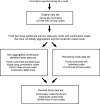The impact of conventional dietary intake data coding methods on foods typically consumed by low-income African-American and White urban populations
- PMID: 25435191
- PMCID: PMC5215865
- DOI: 10.1017/S1368980014002687
The impact of conventional dietary intake data coding methods on foods typically consumed by low-income African-American and White urban populations
Abstract
Objective: Analysing dietary data to capture how individuals typically consume foods is dependent on the coding variables used. Individual foods consumed simultaneously, like coffee with milk, are given codes to identify these combinations. Our literature review revealed a lack of discussion about using combination codes in analysis. The present study identified foods consumed at mealtimes and by race when combination codes were or were not utilized.
Design: Duplicate analysis methods were performed on separate data sets. The original data set consisted of all foods reported; each food was coded as if it was consumed individually. The revised data set was derived from the original data set by first isolating coded foods consumed as individual items from those foods consumed simultaneously and assigning a code to designate a combination. Foods assigned a combination code, like pancakes with syrup, were aggregated and associated with a food group, defined by the major food component (i.e. pancakes), and then appended to the isolated coded foods.
Setting: Healthy Aging in Neighborhoods of Diversity across the Life Span study.
Subjects: African-American and White adults with two dietary recalls (n 2177).
Results: Differences existed in lists of foods most frequently consumed by mealtime and race when comparing results based on original and revised data sets. African Americans reported consumption of sausage/luncheon meat and poultry, while ready-to-eat cereals and cakes/doughnuts/pastries were reported by Whites on recalls.
Conclusions: Use of combination codes provided more accurate representation of how foods were consumed by populations. This information is beneficial when creating interventions and exploring diet-health relationships.
Keywords: African Americans; Dietary assessment methods; Eating occasion; Food coding; Food preferences.
Conflict of interest statement
None.
Figures
References
-
- Park SY, Murphy SP, Wilkens LR et al.. (2005) Dietary patterns using the Food Guide Pyramid groups associated with sociodemographic and lifestyle factors: the Multicohort Study. J Nutr 135, 843–849. - PubMed
-
- Tucker KL (2010) Dietary patterns, approaches, and multicultural perspective. Appl Physiol Nutr Metab 35, 211–218. - PubMed
-
- Raper N, Perloff B, Ingwersen L et al.. (2004) An overview of USDA’s Dietary Intake Data System. J Food Compost Anal 17, 545–555.
-
- Centers for Disease Control and Prevention (2014) NHANES 2009–2010 Dietary Data. http://wwwn.cdc.gov/nchs/nhanes/search/datapage.aspx?Component=Dietary&C... (accessed October 2014).
Publication types
MeSH terms
Grants and funding
LinkOut - more resources
Full Text Sources
Other Literature Sources



